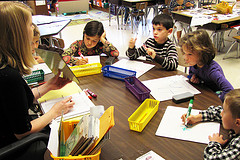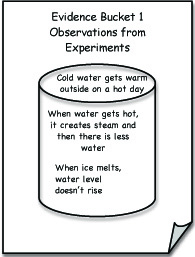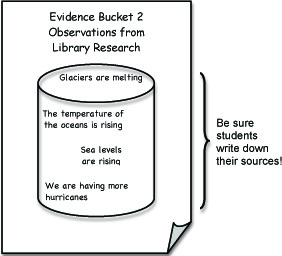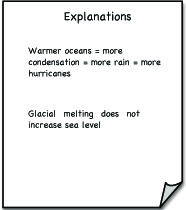In your professional development sessions and reading, you may have heard about the new instructional model called Argument-Driven Inquiry (ADI). It is rooted in the findings of the National Research Council’s report Taking Science to School that “learning to think scientifically is a matter of acquiring problem-solving strategies for coordinating theory and evidence, mastering counterfactual reasoning, distinguishing patterns of evidence that do and do not support a definitive conclusion, and understanding the logic of experimental design” (p. 28).
ADI can help your students gain science literacy through using argument structure, applying scientific reasoning, and communicating in the language of science. To learn more about ADI, check out some of the journal articles listed below.
If you’re feeling that teaching students to construct and communicate arguments is a big activity to undertake alone, know that help is right in your building! Your school librarian’s Standards for the 21st– Century Learner (American Association of School Librarians) call for students to gain experience in the library that will allow them to:
- Inquire, think critically, and gain knowledge. In particular, students have mastery of tools that allow them to read, view, and listen to information in any format and make inferences and gather meaning.
- Draw conclusions, make informed decisions, apply knowledge to new situations, and create new knowledge. They should be able to use the writing process, media and visual literacy, and technology skills to create products that express new understandings.
- Pursue personal and aesthetic growth. In the library, students should respond to creative expressions of ideas in various formats and genres; seek information for personal learning in a variety of formats and genres; use social networks and information tools to gather and share information; display curiosity by pursuing interests through multiple resources; and recognize that resources are created for a variety of purposes.
In helping students gain these important skills, your school librarian is the perfect collaborator. ADI is not a one-lesson or one-library visit activity but also doesn’t need to be a sophisticated debate. The goal of ADI is to help students integrate their observations and the things they read in reputable sources (which ADI calls evidence) into explanations (which ADI calls arguments). Rather, you can work with your school librarian over a few days or even a week to integrate the evidence from science activities you lead and the information-gathering activities he or she leads into arguments that students consider, agree with, or even possibly reject.
For elementary students, a great entry point into ADI is the use of “evidence buckets.” An evidence bucket is a group-created illustration, like the ones below, that reflects all of the information you have collected about a particular topic. You and your librarian can use evidence buckets with your students to learn about weather, states and changes of matter (water), or the water cycle.
To begin, be sure to explore the idea of “evidence” with students. Even the youngest students are likely to have heard the word on television. Encourage them to tell you what they think evidence is. They may be most familiar with evidence as something used in court or by police in criminal investigations. With this starting point, you can help students see that police and lawyers use evidence to explain why something happens and that the person with the most and best evidence is the person whose explanation usually prevails.
With the ideas of evidence and explanation in mind, plan small experiments in which students can observe phenomena relating to weather and water. Invite your school librarian to help facilitate these activities so that you can have multiple groups of children working at once. These activities might include the Science NetLinks activities Water and Ice, Disappearing Water, and Melting and Freezing for primary students. Upper elementary students might investigate weather phenomenon with the unit Wonderful World of Weather. (For other lessons and experiments, refer to Setting the Stage for Understanding the Climate System’s Complex Interactions.)
As the students are completing their experiments, have them present their experiments and their observations to the class. Then, students can record their observations on a drawing of a bucket posted on the wall. This illustration will be their first evidence bucket.
Then, in the library, your students can further explore these concepts with videos like Observe Water in Winter and Summer (grades K-2), Observe Precipitation (grades K-5), or Kid Meteorologist (grades 3-5). For other video clips, search Teachers’ Domain for “water,” “water cycle,” or “weather.”
You and the school librarian can discuss the videos with students in a large group or in small groups to help them gather and develop their observations. Students can add these ideas to a second evidence bucket posted in the library.
On another day, you may choose to do another round of experiments and have students add to or remove things from their first evidence bucket. If possible, you should also extend the time students have to gather information in the library about water, the water cycle, and weather. Your and your school librarian can direct kids to sites like UCAR’s Water Water Everywhere and the EPA’s Climate Change Kids as well as the books, magazines, and databases available in the library (or in our virtual bookshelf). Be sure to have students include where they found the information when they post to the second bucket.
When all of the students have contributed their experiment observations to the buckets, place the bucket illustrations side by side. Include a piece of chart paper labeled explanations. Ask students to look at the contents of both buckets and identify things that might be related. Also ask them why they think the things are related. As students interpret observations from each bucket and explain their reasoning, ask them to write their explanations on the chart paper.
Evidence buckets and argument presentations are powerful tools to help even the youngest students construct explanations related to scientific knowledge. They are also great tools to help students develop communication, information-seeking, and synthesis skills. Later, you can build on this activity to help students use both direct and indirect evidence to make scientific arguments and to seek and synthesize a wider range of information sources. By collaborating with your school librarian, you have two guides for students’ inquiry into climate literacy!
For More Information
Berland, L. K. and Reiser, B. J. 2011. “Classroom Communities’ Adaptations of the Practice of Scientific Argumentation.” Science Education 95: 191–216.
Kulhthau, C.C. 2010. “Guided Inquiry: School Libraries and the 21st Century.” School Libraries Worldwide 16: 17-28.
Sampson, V., Grooms, J. and Walker, J. 2009. “Argument-Driven Inquiry: A Way to Promote Learning During Laboratory Activities.” The Science Teacher, 76(8): 42-47.
Zembal-Saul, C. 2009. “Learning to Teach Elementary School Science as Argument.” Science Education, 93: 687–719.
Resource
Tools for Ambitious Science Teaching: Evidence Buckets
Marcia Mardis, EdD, assistant professor, College of Information Science, Florida State University, wrote this article. Marcia is a former school librarian, school administrator, and educational digital library director. Email Marcia at beyondweather@msteacher.org.
Copyright March 2011 – The Ohio State University. This material is based upon work supported by the National Science Foundation under Grant No. 1034922. Any opinions, findings, and conclusions or recommendations expressed in this material are those of the author(s) and do not necessarily reflect the views of the National Science Foundation. This work is licensed under an Attribution-ShareAlike 3.0 Unported Creative Commons license.







